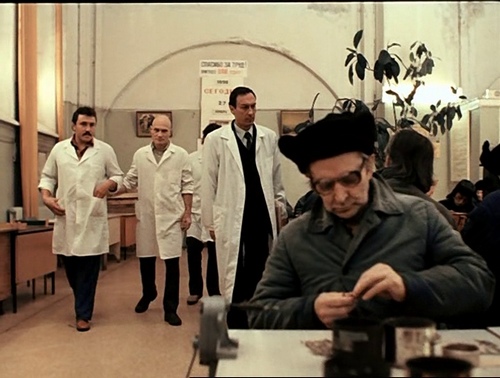
- YouTube link to the English version
- IMDB page for the English version
-  Russian Wikipedia page for Цареубийца
- Â Kino Reticulator’s Ward No. 6 blog entry.
-  Палата №6 at kino-teatr.ru

 Even though he no longer speaks, we watch inmate Dr. Ragin (played by Vladimir Ilin) very carefully to get an idea of his current mental condition, wondering just how aware he is of what’s going on. He’s an inmate in the hospital that he used to run. Nice touch, given the clues we get from the way he eats.  And the ominous, omnipresent Nikita watches, too. And watches us, as well.
Even though he no longer speaks, we watch inmate Dr. Ragin (played by Vladimir Ilin) very carefully to get an idea of his current mental condition, wondering just how aware he is of what’s going on. He’s an inmate in the hospital that he used to run. Nice touch, given the clues we get from the way he eats.  And the ominous, omnipresent Nikita watches, too. And watches us, as well.
I wondered if this scene was in the Chekhov short story that the film is based on, so went to read it here (in English translation). I learned that this scene was not in the original, but even so, the film is remarkably faithful to the original story.
Movies based on books (or a short story, in this case) usually depart so far from it as to be unrecognizable (and so shallow as to be unworthy of the original) or follow it so closely as to be incoherent to one who has not read the original.  American films usually fall into the first category, and Russian films sometimes fall into the second.  But there are some Russian films that are worthy film adaptions of the original.  After reading the story I will state that this film is not only good on its own, but honors the original remarkably well.
There is not much on IMDB about Палата â„–6 (Ward No.6). It’s a 2009 film. It was directed by Alexandr Gornovsky and Karen Shakhnazarov.  I’ve recently watched Shakhnazarov’s Rider named Death, which was good, too, but am otherwise not familiar with his work.
Screenwriter Aleksandr Borodyanskiy did Rider named Death (based on a novel) as well as this one. And Afonya. Maybe I should learn more about his work.  I see that he was born in Vorkuta in 1944. That’s enough to make him interesting already.